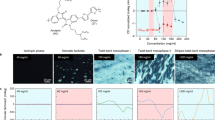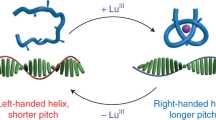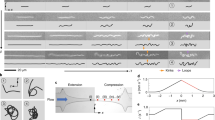Abstract
Helical nanofibres play key roles in many biological processes. Entanglements between helices can aid gelation by producing thick, interconnected fibres, but the details of this process are poorly understood. Here, we describe the assembly of an achiral oligo(urea) peptidomimetic compound into supramolecular helices. Aggregation of adjacent helices leads to the formation of fibrils, which further intertwine to produce high-fidelity braids with periodic crossing patterns. A braid theory analysis suggests that braiding is governed by rigid topological constraints, and that branching occurs due to crossing defects in the developing braids. Mixed-chirality helices assemble into relatively complex, odd-stranded braids, but can also form helical bundles by undergoing inversions of chirality. The oligo(urea) assemblies are also highly sensitive to chiral amplification, proposed to occur through a majority-rules mechanism, whereby trace chiral materials can promote the formation of gels containing only homochiral helices.
This is a preview of subscription content, access via your institution
Access options
Access Nature and 54 other Nature Portfolio journals
Get Nature+, our best-value online-access subscription
$29.99 / 30 days
cancel any time
Subscribe to this journal
Receive 12 print issues and online access
$259.00 per year
only $21.58 per issue
Buy this article
- Purchase on Springer Link
- Instant access to full article PDF
Prices may be subject to local taxes which are calculated during checkout





Similar content being viewed by others
Data availability
All the underlying research data are available from https://doi.org/10.15128/r2cz30ps655 in accordance with the UK Research Councils’ open data policy, and from the corresponding authors upon reasonable request.
References
de Loos, M., Feringa, B. L. & van Esch, J. H. Design and application of self-assembled low molecular weight hydrogels. Eur. J. Org. Chem. https://doi.org/10.1002/ejoc.200400723 (2005).
Terech, P. & Weiss, R. G. Low molecular mass gelators of organic liquids and the properties of their gels. Chem. Rev. 97, 3133–3159 (1997).
Yashima, E. et al. Supramolecular helical systems: helical assemblies of small molecules, foldamers, and polymers with chiral amplification and their functions. Chem. Rev. 116, 13752–13990 (2016).
Yang, S. et al. On the origin of helical mesostructures. J. Am. Chem. Soc. 128, 10460–10466 (2006).
Aggeli, A. et al. Hierarchical self-assembly of chiral rod-like molecules as a model for peptide beta-sheet tapes, ribbons, fibrils and fibers. Proc. Natl Acad. Sci. USA 98, 11857–11862 (2001).
Kurouski, D. et al. Is supramolecular filament chirality the underlying cause of major morphology differences in amyloid fibrils? J. Am. Chem. Soc. 136, 2302–2312 (2014).
Usov, I., Adamcik, J. & Mezzenga, R. Polymorphism complexity and handedness inversion in serum albumin amyloid fibrils. ACS Nano 7, 10465–10474 (2013).
Xing, K. et al. Triple helical molecular braid and parallel packed wavy chain-based supramolecular organic frameworks with conformation- and packing-dependent luminescent properties. Cryst. Growth Des. 16, 4727–4735 (2016).
Weiss, J., Jahnke, E., Severin, N., Rabe, J. P. & Frauenrath, H. Consecutive conformational transitions and deaggregation of multiple-helical poly(diacetylene)s. Nano Lett. 8, 1660–1666 (2008).
Piechocka, I. K. et al. Multi-scale strain-stiffening of semiflexible bundle networks. Soft Matter 12, 2145–2156 (2016).
Jaspers, M. et al. Ultra-responsive soft matter from strain-stiffening hydrogels. Nat. Commun. 5, 5808 (2014).
Pritchard, R. H., Huang, Y. Y. & Terentjev, E. M. Mechanics of biological networks: from the cell cytoskeleton to connective tissue. Soft Matter 10, 1864–1884 (2014).
Gardel, M. L. et al. Elastic behavior of cross-linked and bundled actin networks. Science 304, 1301–1305 (2004).
Burchard, W. Networks in nature. Br. Polym. J. 17, 154–163 (1985).
Everaers, R. et al. Rheology and microscopic topology of entangled polymeric liquids. Science 303, 823–826 (2004).
Armon, S., Aharoni, H., Moshe, M. & Sharon, E. Shape selection in chiral ribbons: from seed pods to supramolecular assemblies. Soft Matter 10, 2733–2740 (2014).
De Abreu, F. V., Dias, R. G. & von Ferber, C. Pseudo-knots in helical structures. Soft Matter 4, 731–734 (2008).
Serna, P., Bunin, G. & Nahum, A. Topological constraints in directed polymer melts. Phys. Rev. Lett. 115, 5 (2015).
Horner, K. E., Miller, M. A., Steed, J. W. & Sutcliffe, P. M. Knot theory in modern chemistry. Chem. Soc. Rev. 45, 6432–6448 (2016).
Fielden, S. D. P., Leigh, D. A. & Woltering, S. L. Molecular knots. Angew. Chem. Int. Ed. 56, 11166–11194 (2017).
Alvariño, C., Simond, D., Lorente, P. M., Besnard, C. & Williams, A. F. Chains, necklaces and weaving chain-link grids from self-assembly reactions. Chem. Eur. J. 21, 8851–8858 (2015).
Yang, G. P., Hou, L., Luan, X. J., Wu, B. A. & Wang, Y. Y. Molecular braids in metal–organic frameworks. Chem. Soc. Rev. 41, 6992–7000 (2012).
Zhang, J. P., Qi, X. L., He, C. T., Wang, Y. & Chen, X. M. Interweaving isomerism and isomerization of molecular chains. Chem. Commun. 47, 4156–4158 (2011).
Byrne, P., Lloyd, G. O., Clarke, N. & Steed, J. W. A ‘compartmental’ borromean weave coordination polymer exhibiting saturated hydrogen bonding to anions and water cluster inclusion. Angew. Chem. Int. Ed. 47, 5761–5764 (2008).
Luan, X. J. et al. An investigation of the self-assembly of neutral, interlaced, triple-stranded molecular braids. Chem. Eur. J. 12, 6281–6289 (2006).
Ashley, C. W. The Ashley Book of Knots 471–510 (Doubleday, New York,1944).
Danon, J. J. et al. Braiding a molecular knot with eight crossings. Science 355, 159–162 (2017).
Sułkowska, J. I. et al. Knotting pathways in proteins. Biochem. Soc. Trans. 41, 523–527 (2013).
Taylor, W. R. Protein knots and fold complexity: some new twists. Comput. Biol. Chem. 31, 151–162 (2007).
Damasceno, P. F., Engel, M. & Glotzer, S. C. Predictive self-assembly of polyhedra into complex structures. Science 337, 453–457 (2012).
Manoharan, V. N., Elsesser, M. T. & Pine, D. J. Dense packing and symmetry in small clusters of microspheres. Science 301, 483–487 (2003).
Whitesides, G. M. & Grzybowski, B. Self-assembly at all scales. Science 295, 2418–2421 (2002).
Meng, S. C., Tang, Y. Q., Yin, Y., Yin, X. L. & Xie, J. M. A theoretical study of molecular conformations and gelation ability of N,N′-dipyridyl urea compounds in ethanol solution: DFT calculations and MD simulations. RSC Adv. 3, 18115–18127 (2013).
van Esch, J., DeFeyter, S., Kellogg, R. M., DeSchryver, F. & Feringa, B. L. Self-assembly of bisurea compounds in organic solvents and on solid substrates. Chem. Eur. J. 3, 1238–1243 (1997).
Jones, J. E. et al. Length-dependent formation of transmembrane pores by 310-helical α-aminoisobutyric acid foldamers. J. Am. Chem. Soc. 138, 688–695 (2016).
Piguet, C., Bernardinelli, G. & Hopfgartner, G. Helicates as versatile supramolecular complexes. Chem. Rev. 97, 2005–2062 (1997).
King, P. J. S. et al. A modular self-assembly approach to functionalised β-sheet peptide hydrogel biomaterials. Soft Matter 12, 1915–1923 (2016).
Saiani, A. et al. Self-assembly and gelation properties of α-helix versus β-sheet forming peptides. Soft Matter 5, 193–202 (2009).
Nagarkar, R. P., Hule, R. A., Pochan, D. J. & Schneider, J. P. De novo design of strand-swapped β-hairpin hydrogels. J. Am. Chem. Soc. 130, 4466–4474 (2008).
Escuder, B., Rodríguez-Llansola, F. & Miravet, J. F. Supramolecular gels as active media for organic reactions and catalysis. New J. Chem. 34, 1044–1054 (2010).
Steed, J. W. Anion-tuned supramolecular gels: a natural evolution from urea supramolecular chemistry. Chem. Soc. Rev. 39, 3686–3699 (2010).
Foster, J. A. et al. Pharmaceutical polymorph control in a drug-mimetic supramolecular gel. Chem. Sci. 8, 78–84 (2017).
Foster, J. A. et al. Anion-switchable supramolecular gels for controlling pharmaceutical crystal growth. Nat. Chem. 2, 1037–1043 (2010).
Catrouillet, S. et al. Patchy supramolecular bottle-brushes formed by solution self-assembly of bis(urea)s and tris(urea)s decorated by two incompatible polymer arms. Langmuir 32, 8900–8908 (2016).
Aisenbrey, C., Pendem, N., Guichard, G. & Bechinger, B. Solid state NMR studies of oligourea foldamers: interaction of 15N-labelled amphiphilic helices with oriented lipid membranes. Org. Biomol. Chem. 10, 1440–1447 (2012).
Stanley, C. E. et al. Anion binding inhibition of the formation of a helical organogel. Chem. Commun. 2006, 3199–3201 (2006).
de Loos, M. et al. Tripodal tris-urea derivatives as gelators for organic solvents. Eur. J. Org. Chem. 2000, 3675–3678 (2000).
Artin, E. Theory of braids. Ann. Math. 48, 101–125 (1947).
Coubrough, H. M., Jones, C. D., Yufit, D. S. & Steed, J. W. Gelation by histidine-derived ureas. Supramol. Chem. 30, 384–394 (2018).
James, S. J., Perrin, A., Jones, C. D., Yufit, D. S. & Steed, J. W. Highly interlocked anion-bridged supramolecular networks from interrupted imidazole–urea gels. Chem. Commun. 50, 12851–12854 (2014).
Dzwolak, W. Chirality and chiroptical properties of amyloid fibrils. Chirality 26, 580–587 (2014).
Serpell, L. C. Alzheimer’s amyloid fibrils: structure and assembly. Biochim. Biophys. Acta 1502, 16–30 (2000).
Duspara, P. A., Islam, M. S., Lough, A. J. & Batey, R. A. Synthesis and reactivity of N-alkyl carbamoylimidazoles: development of N-methyl carbamoylimidazole as a methyl isocyanate equivalent. J. Org. Chem. 77, 10362–10368 (2012).
Meazza, L. et al. Halogen-bonding-triggered supramolecular gel formation. Nat. Chem. 5, 42–47 (2013).
Piepenbrock, M. O. M., Clarke, N. & Steed, J. W. Shear induced gelation in a copper(ii) metallogel: new aspects of ion-tunable rheology and gel-reformation by external chemical stimuli. Soft Matter 6, 3541–3547 (2010).
Todd, A. M., Anderson, K. M., Byrne, P., Goeta, A. E. & Steed, J. W. Helical or polar guest-dependent Z′ = 1.5 or Z′ = 2 forms of a sterically hindered bis(urea) clathrate. Cryst. Growth Des. 6, 1750–1752 (2006).
Terech, P., Pasquier, D., Bordas, V. & Rossat, C. Rheological properties and structural correlations in molecular organogels. Langmuir 16, 4485–4494 (2000).
Van der Spoel, D. et al. GROMACS: fast, flexible, and free. J. Comput. Chem. 26, 1701–1718 (2005).
Case, D. A. et al. The amber biomolecular simulation programs. J. Comput. Chem. 26, 1668–1688 (2005).
Pyrlin, S. V., Hine, N. D. M., Kleij, A. W. & Ramos, M. M. D. Self-assembly of bis-salphen compounds: from semiflexible chains to webs of nanorings. Soft Matter 14, 1181–1194 (2018).
Eckes, K. M., Mu, X., Ruehle, M. A., Ren, P. & Suggs, L. J. β sheets not required: combined experimental and computational studies of self-assembly and gelation of the ester-containing analogue of an Fmoc-dipeptide hydrogelator. Langmuir 30, 5287–5296 (2014).
Forman, C. J., Fejer, S. N., Chakrabarti, D., Barker, P. D. & Wales, D. J. Local frustration determines molecular and macroscopic helix structures. J. Phys. Chem. B 117, 7918–7928 (2013).
Huang, M.-J., Kapral, R., Mikhailov, A. S. & Chen, H.-Y. Coarse-grain model for lipid bilayer self-assembly and dynamics: multiparticle collision description of the solvent. J. Chem. Phys. 137, 055101 (2012).
Jones, C. D., Kennedy, S. R., Walker, M., Yufit, D. S. & Steed, J. W. Scrolling of supramolecular lamellae in the hierarchical self-assembly of fibrous gels. Chem 3, 603–628 (2017).
Núñez-Villanueva, D. et al. H-bond self-assembly: folding versus duplex formation. J. Am. Chem. Soc. 139, 6654–6662 (2017).
Fitzpatrick, A. W. P. et al. Atomic structure and hierarchical assembly of a cross-β amyloid fibril. Proc. Natl Acad. Sci. USA 110, 5468 (2013).
Velikov, K. P., Christova, C. G., Dullens, R. P. A. & van Blaaderen, A. Layer-by-layer growth of binary colloidal crystals. Science 296, 106–109 (2002).
Baumgartner, R., Fu, H., Song, Z., Lin, Y. & Cheng, J. Cooperative polymerization of α-helices induced by macromolecular architecture. Nat. Chem. 9, 614–622 (2017).
Müller, M. F., Ris, H. & Ferry, J. D. Electron microscopy of fine fibrin clots and fine and coarse fibrin films. J. Mol. Biol. 174, 369–384 (1984).
Xu, F. et al. Self-assembly of left- and right-handed molecular screws. J. Am. Chem. Soc. 135, 18762–18765 (2013).
Sia, S. K. & Kim, P. S. A designed protein with packing between left-handed and right-handed helices. Biochemistry 40, 8981–8989 (2001).
Morrow, S. M., Bissette, A. J. & Fletcher, S. P. Transmission of chirality through space and across length scales. Nat. Nanotechnol. 12, 410–419 (2017).
Duan, P., Cao, H., Zhang, L. & Liu, M. Gelation induced supramolecular chirality: chirality transfer, amplification and application. Soft Matter 10, 5428–5448 (2014).
Tomsett, M. et al. A tendril perversion in a helical oligomer: trapping and characterizing a mobile screw-sense reversal. Chem. Sci. 8, 3007–3018 (2017).
Dafforn, T. R. & Rodger, A. Linear dichroism of biomolecules: which way is up? Curr. Opin. Struct. Biol. 14, 541–546 (2004).
Ribó, J. M., Hochberg, D., Crusats, J., El-Hachemi, Z. & Moyano, A. Spontaneous mirror symmetry breaking and origin of biological homochirality. J. R. Soc. Interface 14, 20170699 (2017).
Palmans Anja, R. A., Vekemans Jef, A. J. M., Havinga Edsko, E. & Meijer, E. W. Sergeants‐and‐soldiers principle in chiral columnar stacks of disc‐shaped molecules with C3 symmetry. Angew. Chem. Int. Ed. 36, 2648–2651 (2003).
Ogi, S., Sugiyasu, K., Manna, S., Samitsu, S. & Takeuchi, M. Living supramolecular polymerization realized through a biomimetic approach. Nat. Chem. 6, 188–195 (2014).
Azeroual, S. et al. Mirror symmetry breaking and chiral amplification in foldamer-based supramolecular helical aggregates. Chem. Commun. 48, 2292–2294 (2012).
Prins, L. J., Timmerman, P. & Reinhoudt, D. N. Amplification of chirality: the ‘sergeants and soldiers’ principle applied to dynamic hydrogen-bonded assemblies. J. Am. Chem. Soc. 123, 10153–10163 (2001).
Langeveld-Voss, B. M. W., Waterval, R. J. M., Janssen, R. A. J. & Meijer, E. W. Principles of ‘majority rules’ and ‘sergeants and soldiers’ applied to the aggregation of optically active polythiophenes: Evidence for a multichain phenomenon. Macromolecules 32, 227–230 (1999).
Petkova, A. T. et al. Self-propagating, molecular-level polymorphism in Alzheimer’s ß-amyloid fibrils. Science 307, 262–265 (2005).
Masel, J., Jansen, V. A. A. & Nowak, M. A. Quantifying the kinetic parameters of prion replication. Biophys. Chem. 77, 139–152 (1999).
Ruiz-Mirazo, K., Briones, C. & de la Escosura, A. Prebiotic systems chemistry: new perspectives for the origins of life. Chem. Rev. 114, 285–366 (2014).
Hule, R. A., Nagarkar, R. P., Hammouda, B., Schneider, J. P. & Pochan, D. J. Dependence of self-assembled peptide hydrogel network structure on local fibril nanostructure. Macromolecules 42, 7137–7145 (2009).
Ozbas, B., Kretsinger, J., Rajagopal, K., Schneider, J. P. & Pochan, D. J. Salt-triggered peptide folding and consequent self-assembly into hydrogels with tunable modulus. Macromolecules 37, 7331–7337 (2004).
Acknowledgements
The authors thank the Engineering and Physical Sciences Research Council for funding this work via a Doctoral Training Studentship awarded to C.D.J. and the Leverhulme Trust for supporting K.E.H. via the Scientific Properties of Complex Knots (SPOCK) Research Programme Grant. The authors also thank L. Bowen, B. Mendis and S. Boothroyd for their assistance in obtaining electron microscopy images and rheological data.
Author information
Authors and Affiliations
Contributions
C.D.J., H.T.D.S. and K.L. performed the synthesis of new compounds. R.L.T. and H.T.D.S. carried out the AFM measurements. K.E.H. and C.D.J. analysed the braid topologies. C.D.J. completed the remaining experimental studies. J.W.S. was responsible for overall project concept, direction and coordination. C.D.J. and J.W.S. wrote the manuscript.
Corresponding author
Ethics declarations
Competing interests
The authors declare no competing interests.
Additional information
Publisher’s note: Springer Nature remains neutral with regard to jurisdictional claims in published maps and institutional affiliations.
Supplementary information
Supplementary Information
Details of the synthesis, experimental procedures, compound characterization, scanning electron microscopy, transmission electron microscopy, atomic force microscopy, powder X-ray diffraction, rheometry, braiding and chiral amplification information, a description of braid theory, molecular dynamics details and the MD topology file.
Rights and permissions
About this article
Cite this article
Jones, C.D., Simmons, H.T.D., Horner, K.E. et al. Braiding, branching and chiral amplification of nanofibres in supramolecular gels. Nat. Chem. 11, 375–381 (2019). https://doi.org/10.1038/s41557-019-0222-0
Received:
Accepted:
Published:
Issue Date:
DOI: https://doi.org/10.1038/s41557-019-0222-0
This article is cited by
-
Biomimetic chiral hydrogen-bonded organic-inorganic frameworks
Nature Communications (2024)
-
Chiral transfer amidst one-dimensional linear polymers and two-dimensional network covalent organic frameworks: Striking a fine balance between helicity and crystallinity
Nano Research (2024)
-
Genesis of an ecofriendly An + B3 hyperbranched polyester from Poly (ethylene glycol) and aconitic acid for application as flocculant
Journal of Polymer Research (2024)
-
Supramolecular glasses with color-tunable circularly polarized afterglow through evaporation-induced self-assembly of chiral metal–organic complexes
Nature Communications (2023)
-
Controlling assembly-induced symmetry-breaking by tuning the vortex-responsive nanostructures
Nano Research (2023)



